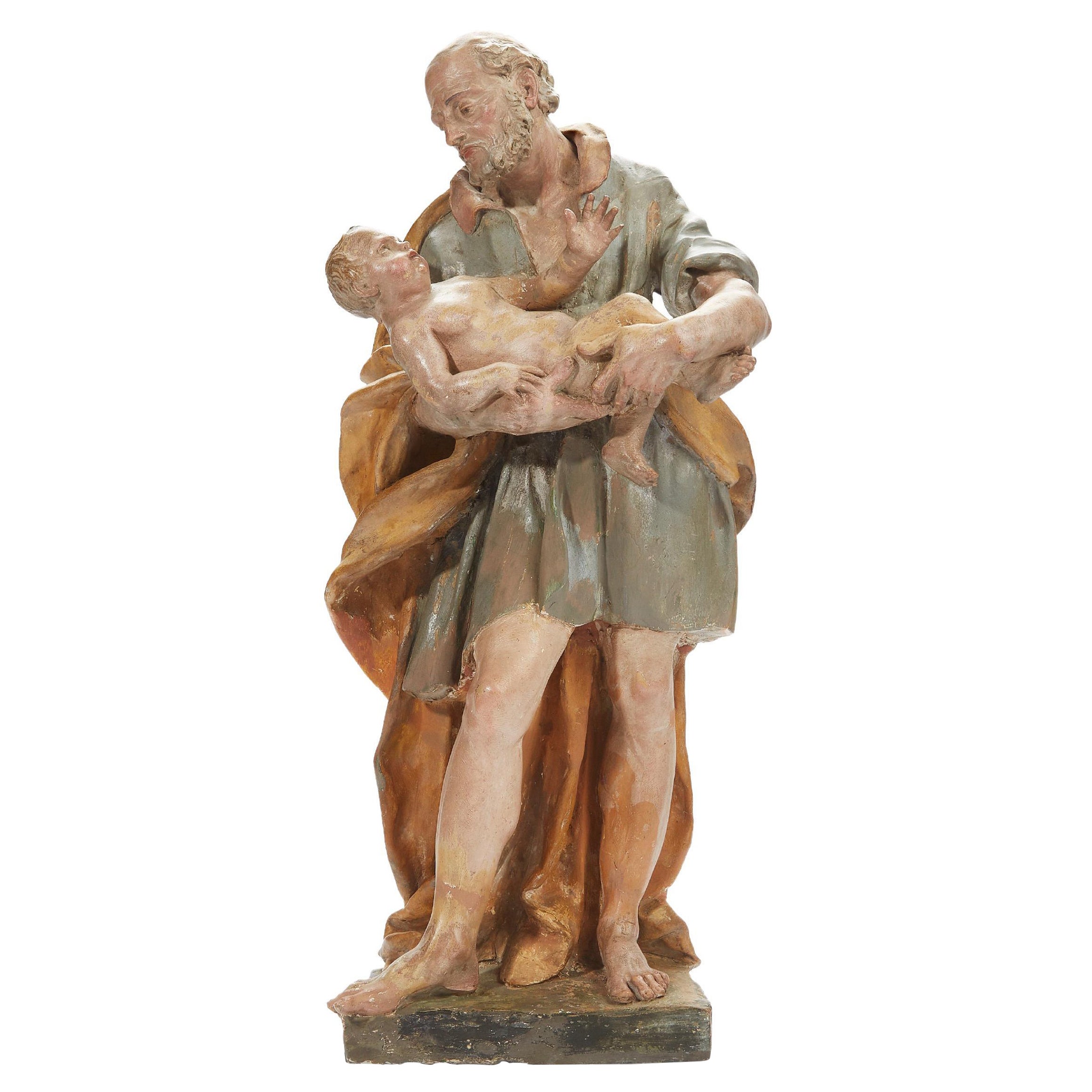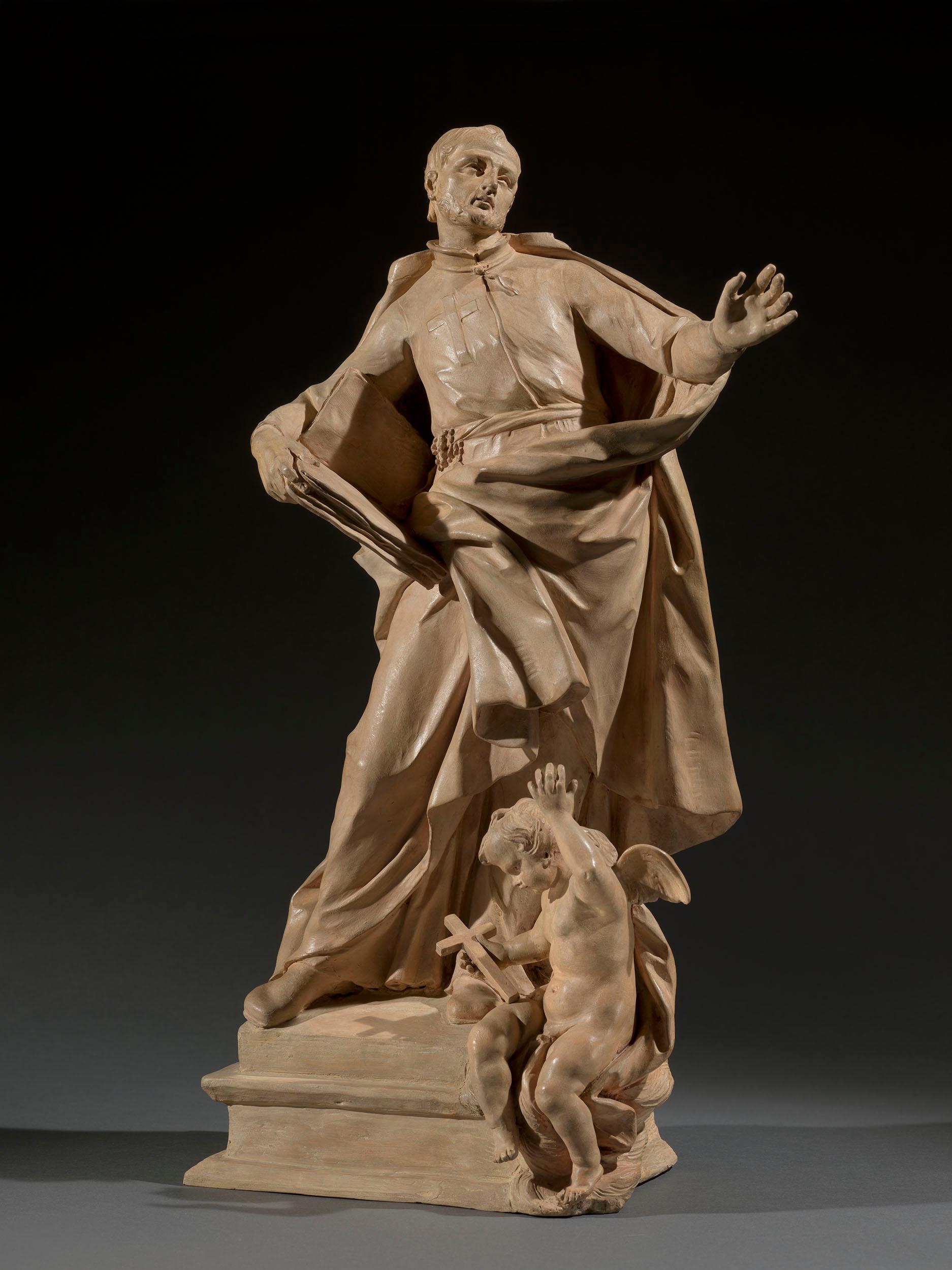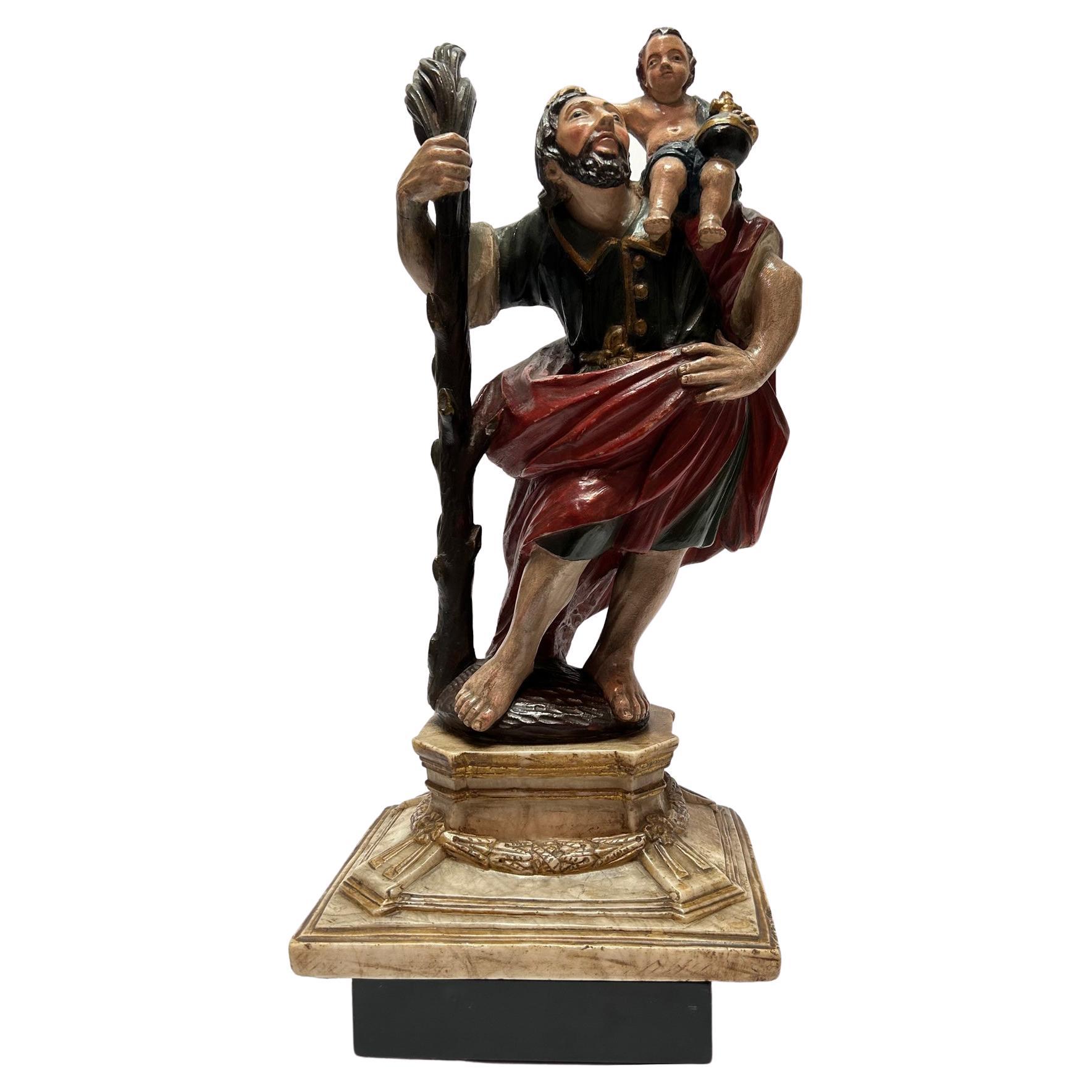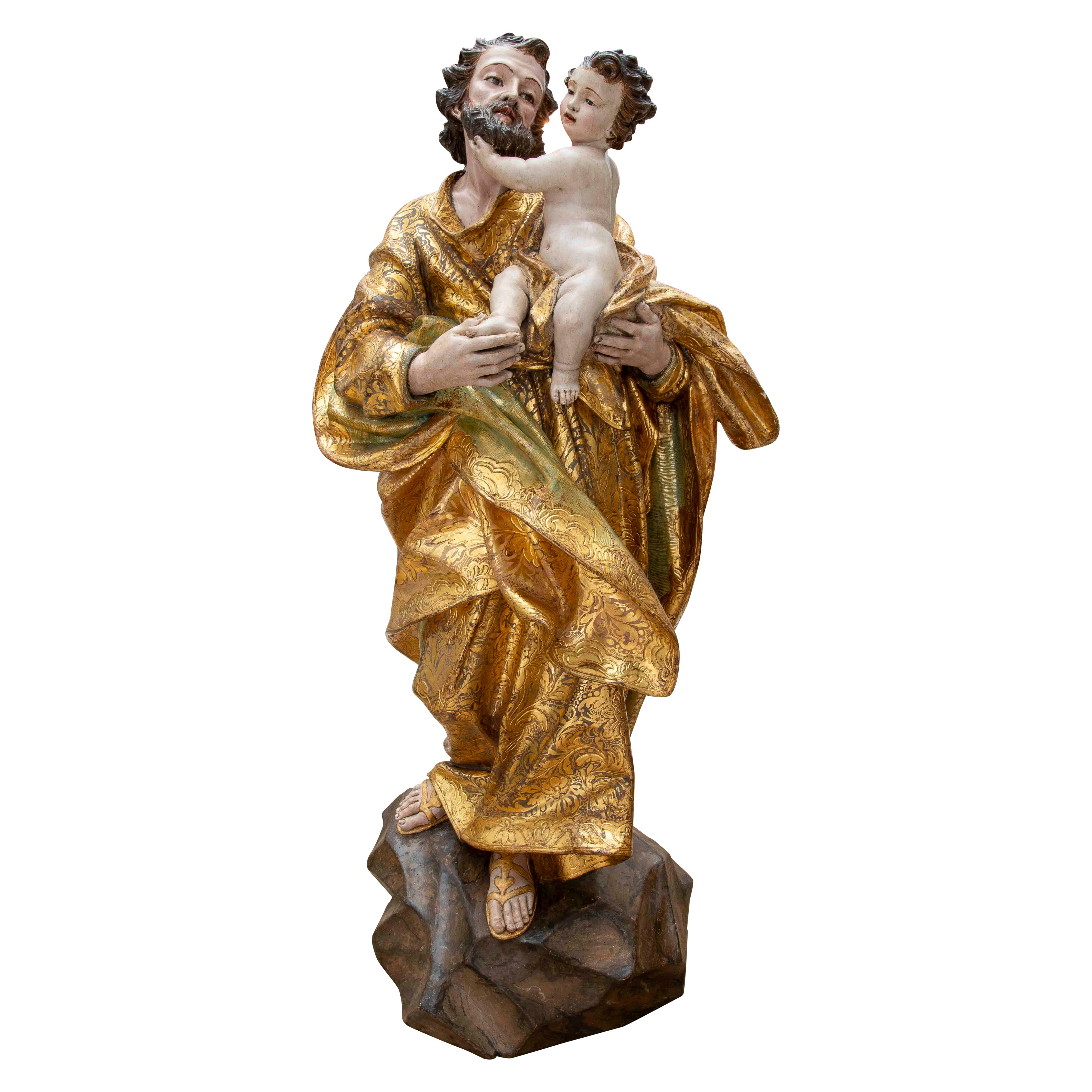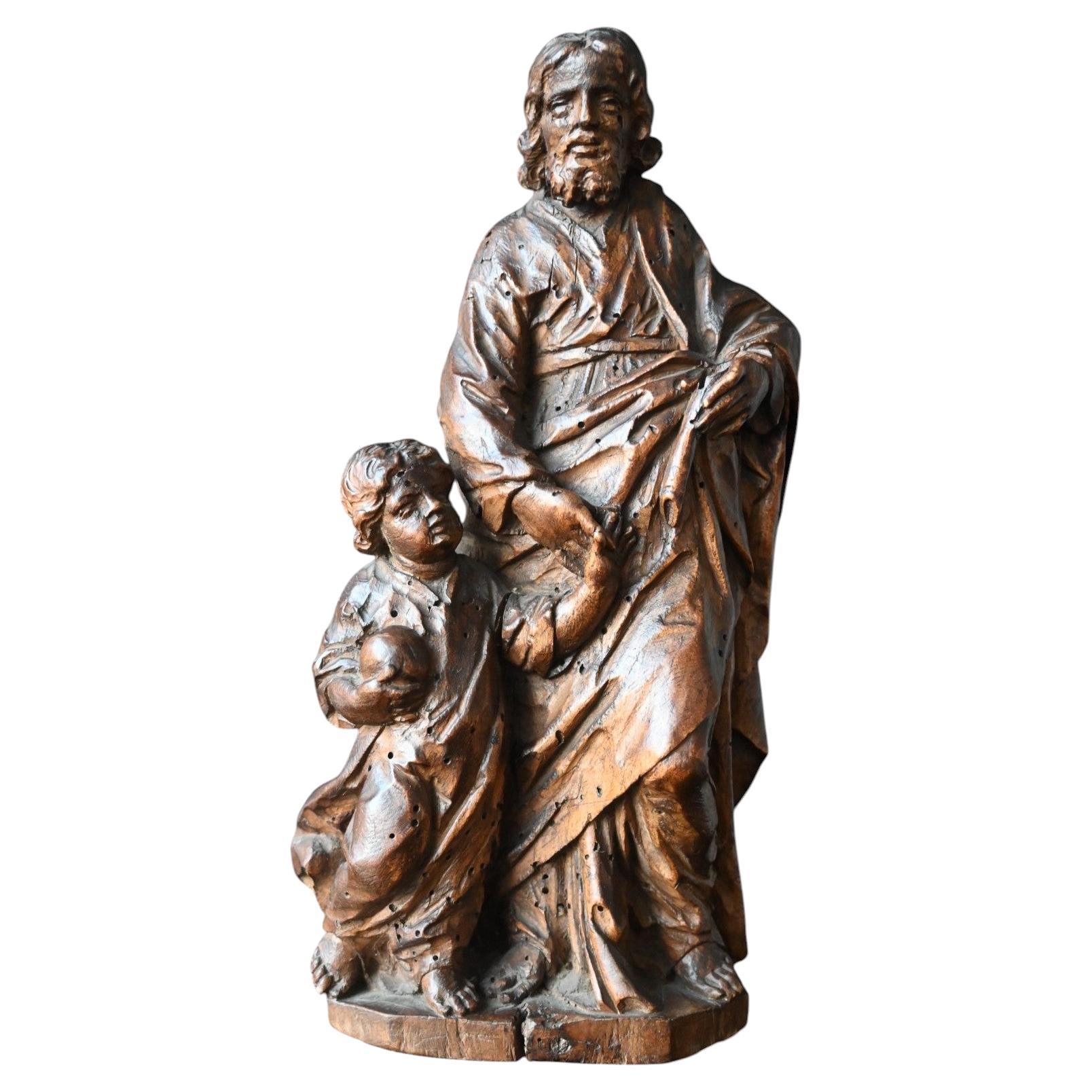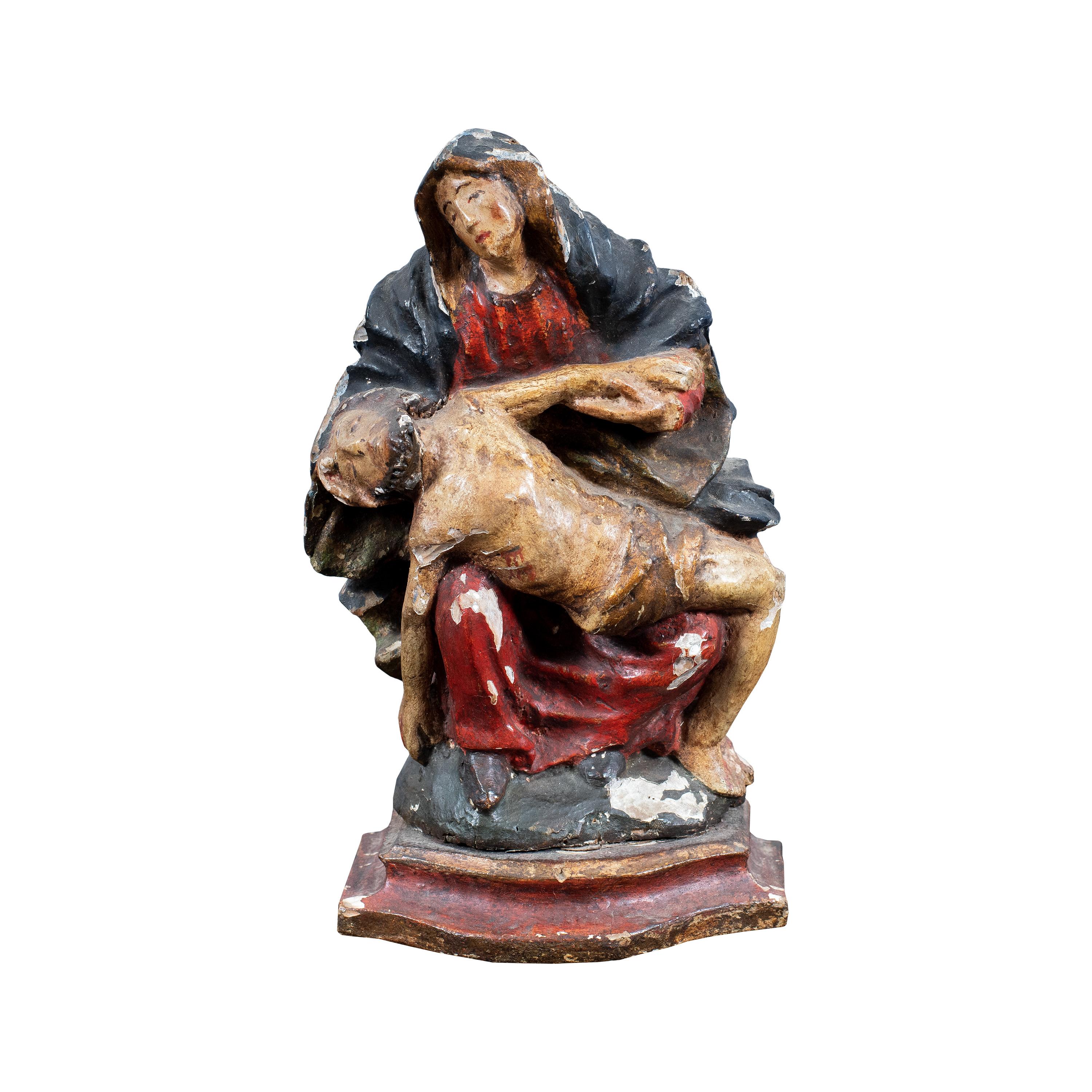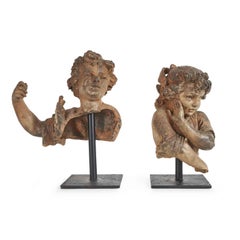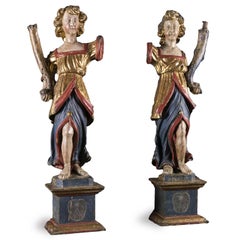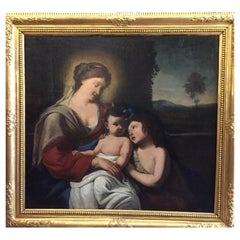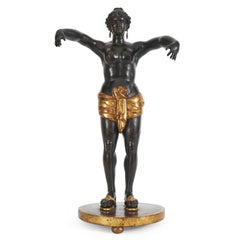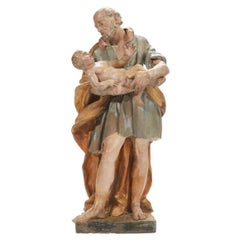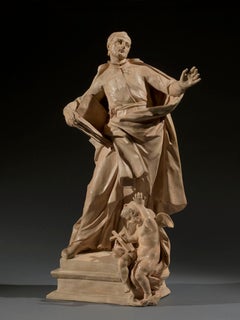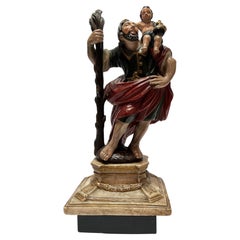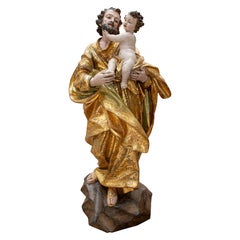Items Similar to St. Joseph with Child Terracotta Bolognese School 18th Century Gabriello Pio
Video Loading
Want more images or videos?
Request additional images or videos from the seller
1 of 22
St. Joseph with Child Terracotta Bolognese School 18th Century Gabriello Pio1750 about
1750 about
$3,549.31
£2,698.07
€3,000
CA$4,988.02
A$5,424.58
CHF 2,857.79
MX$65,882.60
NOK 35,928.22
SEK 33,679.81
DKK 22,973.60
About the Item
St. Joseph with Child in Terracotta beautiful example of Bolognese plastic from the 1700s, circle of Angelo Gabriello Piò (Bologna 1690 - 1770).
Modeled as a full-length figure, the saint is resting on a square base, dressed in an ochre cloak over a greenish-colored smock and barefoot. In her arms she holds the Babe with open arms as they both look lovingly at each other.
The sculpture has been restored since in the past, to remedy a repair on the legs an integrative restoration was done, completing the drapery of the surplice up to the base to promote stability. The figure was restored to its original condition by removing all additions. The St. Joseph dates from the 1700s and comes from a private collection in Milan.
We ship from Italy, Every antique must have an export license from the Italian Ministry of Culture, called Bella Arti, to apply for and obtain it you must consider an additional 2-3 weeks of processing time, to be added to the shipping time.
Periodo: 1700
Altezza: 52.5 cm
Width: 20 cm
Profondità: 15.5 cm
- Creation Year:1750 about
- Dimensions:Height: 20.87 in (53 cm)Width: 7.88 in (20 cm)Depth: 6.3 in (16 cm)
- Medium:
- Movement & Style:
- Circle Of:Angelo Gabriello Piò (1690 - 1770, Italian)
- Period:
- Condition:The sculpture has been restored as in the past, to remedy a repair on the legs an integrative restoration was done, completing the drapery of the surplice up to the base to promote stability. The figure was brought back to the condi.
- Gallery Location:Milano, IT
- Reference Number:Seller: a7771stDibs: LU2861216265432
About the Seller
No Reviews Yet
Vetted Professional Seller
Every seller passes strict standards for authenticity and reliability
1stDibs seller since 2025
- ShippingRetrieving quote...Shipping from: Milano, Italy
- Return Policy
Authenticity Guarantee
In the unlikely event there’s an issue with an item’s authenticity, contact us within 1 year for a full refund. DetailsMoney-Back Guarantee
If your item is not as described, is damaged in transit, or does not arrive, contact us within 7 days for a full refund. Details24-Hour Cancellation
You have a 24-hour grace period in which to reconsider your purchase, with no questions asked.Vetted Professional Sellers
Our world-class sellers must adhere to strict standards for service and quality, maintaining the integrity of our listings.Price-Match Guarantee
If you find that a seller listed the same item for a lower price elsewhere, we’ll match it.Trusted Global Delivery
Our best-in-class carrier network provides specialized shipping options worldwide, including custom delivery.More From This Seller
View AllPair Of Terracotta Children Italian Romantic Busts Late 1800s
Located in Milano, IT
Pair of Fragments Of Late 1800s Romantic Sculptures, Pair of Terracotta Busts of Children probably part of a fountain, of a larger sculptural group. These are busts of a child with ...
Category
Late 19th Century Romantic Figurative Sculptures
Materials
Terracotta
Pair of Italian Baroque Angels 17th Century Sculptured Lacquered and Gilded Figures
Located in Milano, IT
Pair of Angels, Tuscan Sculptures with Cornucopias from the 1600s hand-carved from stone pine wood, lacquered and gilded from Central Italy, from a private villa in Siena; they are...
Category
Late 17th Century Baroque Figurative Sculptures
Materials
Wood
Madonna With Child and St. John 17th century Italian Lombard School
Located in Milano, IT
Italian religious painting of the Lombard School Madonna and Child with St. John ca. 1650 with a good balanced and harmonious composition in the center of which is the Child with hi...
Category
Mid-17th Century Baroque Figurative Paintings
Materials
Gold Leaf
Goddess Circe Italian Neoclassical Sculpture Carved Wood Ebony and Gold 1800s
Located in Milano, IT
Circe 19th-century Italian Wooden Sculpture, the proposed neoclassical figure is a fascinating and rare depiction of the Goddess Circe, made in the early 1800s. The pine wood carving...
Category
Early 19th Century Italian School Figurative Sculptures
Materials
Wood
St. Peter and the Rooster Italian School 17th Century Oil Painting on Canvas
Located in Milano, IT
St. Peter And The Rooster 1600 oil painting on canvas reinteled with new frame. The painting was probably part of a larger composition depicting St. Peter repenting, weeping. Italian...
Category
Mid-17th Century Baroque Portrait Paintings
Materials
Canvas, Oil
Banquet with Figures Memento Mori Italian 17th Century After Giovanni Martinelli
Located in Milano, IT
Antique Painting of 1600s Banquet with Figures Memento Mori after Giovanni Martinelli death comes to the banquet table-memento mori circa 1635. The oil on canvas painting (lined with...
Category
Mid-17th Century Baroque Figurative Paintings
Materials
Canvas, Oak, Oil
You May Also Like
San Giuseppe con Bambino Terracotta Barocca Italiana XVIII Secolo da Pio A.G.
By Angelo Gabriello Piò
Located in Milano, MI
San Giuseppe con Bambino in Terracotta splendido esempio di plastica bolognese del 1700, dalla cerchia dello scultore italiano Angelo Gabriello Piò (Bologna 1690 – 1770).
Modellato...
Category
Antique Early 18th Century Italian Baroque Figurative Sculptures
Materials
Terracotta
Roman 18th century terracotta model for the sculpture of San Camillo de Lellis
Located in London, GB
This remarkably fluid terracotta bozetto was made in preparation for Pietro Pacilli’s most important public commission, a large-scale marble statue of San Camillo de Lellis for the nave of St Peter’s Basilica in Rome. Expressively modelled, this terracotta sculpture is a rare and significant work made by a major Roman sculptor at a transformative moment of European sculpture. Pacilli began his working life on the great Baroque decorative projects initiated in the seventeenth century, but he found success as a restorer of ancient sculpture working to finish antiquities for a tourist market, becoming an important figure in the emergence of an archaeologically minded Neoclassicism. Pacilli trained Vincenzo Pacetti and provided important decorative work for the Museo Pio-Clementino, at the same time he is recorded restoring some of the most celebrated antiquities excavated and exported during the period.
Pacilli was born into a family of Roman craftsmen, his father Carlo was a wood carver, and Pacilli is recorded working with him on the Corsini Chapel in San Giovanni Laternao as early as 1735. In 1738 his terracotta model of Joseph and Potiphar’s Wife won the first prize in the second class of the sculpture concorso at the Accademia di San Luca, this is particularly notable as Bartolomeo Cavaceppi came third. He worked as a carver and stuccoist completing works for the churches of San Marco and SS. Trinita dei Domeniciani Spagnoli. Pacilli operated as a sculptor and restorer of antiquities from his studio at the top of the Spanish Steps, close to Santa Trinita dei Monti, where he is listed as a potential vendor to the Museo Pio-Clementino in 1770.
In 1763 Pacilli completed a silver figure of San Venanzio for the treasury of San Venanzio. He is recorded as Pacetti’s first master and it was evidently through Pacilli that he began to acquire his facility as a restorer of ancient sculpture. Pacilli, at his studio ‘poco prima dell’Arco della Regina alla Trinita dei Monti,’ exercised, what the nineteenth-century scholar, Adolf Michaelis called ‘rejuvenating arts’ on several important pieces of classical sculpture, including in 1760 the group of a Satyr with a Flute for the natural brother of George III, General Wallmoden, Hanovarian minister at Vienna. In 1765, Dallaway and Michaelis record that Pacilli was responsible for the restorations, including the addition of a new head, to the Barberini Venus which he had acquired from Gavin Hamilton. The Venus was then sold to Thomas Jenkins, who in turn passed it on to William Weddell at Newby Hall. In 1767 Pacilli exported a series of ancient busts ‘al naturale’ including portraits of Antinous, Julius Ceaser and Marus Aurelius, also a statue of a Muse and a Venus. As early as 1756 Pacilli seems to have been operating as an antiquarian, helping to disperse the collection of the Villa Borrioni. Pacilli supplied sculpture to notable British collectors, including Charles Townley, who on his first trip to Italy purchased the Palazzo Giustiniani statue of Hecate from Pacilli. Pacilli was involved with the Museo Pio Clementino from its conception, supplying busts of Julius Ceaser and a Roman Woman as well as completing stucco putti surmounting the arms of Pope Bendedict XIV to signal the entrance to the new Museo Critiano.
In 1750 Il Diario Ordinario del Chracas announced that Pacilli had begun work on a sculpture of San Camillo de Lellis for St Peter’s. Camillo de Lellis founded his congregation, the Camillians, with their distinctive red felt crosses stitched on black habits in 1591. Having served as a soldier in the Venetian army, Camillo de Lellis became a novitiate of the Capuchin friars, he moved to Rome and established a religious community for the purpose of caring for the sick. In 1586 Pope Sixtus V formerly recognised the Camillians and assigned them to the Church of Santa Maria Maddalena in Rome. Camillo de Lellis died in 1614 and was entombed at Santa Maria Maddalena, he was canonised by Benedict XIV on June 26, 1746. It was an occasion that prompted the Camillians to make a number of significant artistic commissions, including two canvases by Pierre Subleyras showing episodes from San Camillo’s life which they presented to Benedict XIV. In 1750 Pacilli was commissioned to fill one of the large niches on the north wall of the nave with a sculpture of San Camillo.
The present terracotta bozetto presumably had two important functions, to enable Pacilli to work out his ideas for the finished sculpture and at the same time to show his design to the various commissioning bodies. In this case it would have been Cardinal Alessandro Albani and Monsignor Giovan Francesco Olivieri, the ‘economo’ or treasurer of the fabric of St Peter’s. Previously unrecorded, this terracotta relates to a smaller, less finished model which has recently been identified as being Pacilli’s first idea for his statue of San Camillo. Preserved in Palazzo Venezia, in Rome, the terracotta shows San Camillo with his left hand clutching his vestments to his breast; the pose and action more deliberate and contained than the finished sculpture. In producing the present terracotta Pacilli has expanded and energised the figure. San Camillo is shown with his left hand extended, his head turned to the right, apparently in an attempt to look east down the nave of St Peter’s. The model shows Pacilli experimenting with San Camillo’s costume; prominently on his breast is the red cross of his order, whilst a sense of animation is injected into the figure through the billowing cloak which is pulled across the saint’s projecting right leg. The power of the restrained, axial contrapposto of bent right leg and outstretched left arm, is diminished in the final sculpture where a baroque fussiness is introduced to the drapery. What Pacilli’s terracotta demonstrates, is that he conceived the figure of San Camillo very much in line with the immediate tradition of depicting single figures in St Peter’s; the rhetorical gesture of dynamic saint, arm outstretched, book in hand, head pointed upwards was perhaps borrowed from Camillo Rusconi’s 1733 sculpture of St. Ignatius...
Category
18th Century Baroque Figurative Sculptures
Materials
Terracotta
Christopher Circa 1600 Alabaster
Located in Esbeek, NL
This Albast statue depicting Saint Christopher, beautiful polychrome
Circa 1600
Alabaster
Category
Antique 17th Century European Figurative Sculptures
Materials
Alabaster
17th Baroque Sculpture of Saint Joseph & the Child, Polychrome & Gilded Carving
Located in Marbella, ES
A majestic sculpture in the round depicting Saint Joseph with the Child Jesus, made of carved, polychrome, and water-gilded wood using the gilding technique. The piece, probably orig...
Category
Antique 17th Century Spanish Figurative Sculptures
Materials
Gold
Baroque Walnut Sculpture Of Saint Joseph And The Christ Child, Early 18th C.
Located in Bilzen, BE
"Baroque Walnut Sculpture Of Saint Joseph And The Christ Child, Early 18th Century"
Baroque Walnut Sculpture of Saint Joseph and the Christ Child
Southern Netherlands or Germanic Reg...
Category
Antique Early 18th Century Baroque Religious Items
Materials
Wood
Italian master - 18th century figure sculpture - Virgin Pity - Carved Wood Paint
Located in Varmo, IT
Carved and painted wooden sculpture - Pietà - Italy, 18th century.
13 x 7 x h 22.5 cm.
Entirely made of carved and polychrome painted wood.
Condition report: Good state of conserv...
Category
Mid-18th Century Old Masters Figurative Sculptures
Materials
Paint, Wood
More Ways To Browse
Bronze Bastet Cat
Bronze Mountain Lion
Bronze Western Indian Art
Cafe Florian
Canoe Paddle Africa
Cesar Thumb
Charna Rickey On Sale
Chen Si
Chola Bronze
Chris Fraticelli
Christopher David White
Clark Bronson
Contemporary Art W Swimmers
Dali Bronze Christ John Cross
Dali Bronze John Saint
Dali Bronze Watch
Dali Gold Relief
Dali Silver Christ
